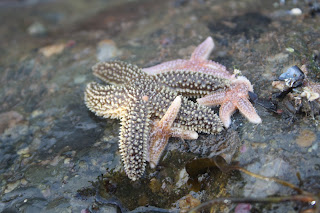Sometimes reality can be scarier than fiction! Imagine a room filled with jars and jars of pickled specimens gathered from the recesses of the deep, dark ocean. Walking through this room all you see are big eyes staring at you and mouths gaping open revealing long, sharp teeth. In reality this spooky place is the Huntsman’s Atlantic Reference Centre (ARC), a research museum housing thousands of specimens of North Atlantic marine life. Below is a sampling of the scary deep sea creatures found at the ARC. Happy Halloween!
Monday, 31 October 2011
Saturday, 29 October 2011
Harbour View High Day 2
This morning the students and teachers from the Marine Biology class of Harbour View High were up bright and early to head out to Indian Point. This mixed habitat intertidal zone presented an excellent location for the students to explore. They found a diversity of organisms, including green crabs, a sea slug, sea cucumbers, sea stars, sea urchins, periwinkles, scale worms, sea vases, terebellid worms, and bread crumb sponge. What a great morning on the beach! Much better than the rain and wind storm last year!
Stars found at Indian Point
Back in the lab the students did an experiment to test the effect of temperature change on barnacles. I think they were surprised to see how the barnacles feed.
Friday, 28 October 2011
Welcome Harbour View High!
The last students of the fall field season have arrived! For the next two days grade 11 and 12 Marine Biology students from Harbour View High School, Saint John, NB will get a chance to work first hand with the organisms they have been learning about. Today the students have classified invertebrates (watch out for the squirting scallop!), looked at plankton under the microscope, collected samples while on our research vessel, the Fundy Spray (brrrr its cold out there!) and experimented with sea stars and urchins. Looking forward to hitting the beach tomorrow!
Hermit crab
Urchin with tube feet extended.
Thursday, 27 October 2011
Creature Feature - Blood worm
A favourite activity of students visiting the Huntsman is a field trip to a muddy beach. Armed with buckets and shovels the students head out in search of animals that burrow into the sediments when the tide is out.
One of the interesting creatures the students find in the mud is the blood worm (Glycera dibranchiata). A cool feature of this worm is that it feeds by shooting out a proboscis with four small fangs on the end. The fangs are connected to glands that supply poison which they use to kill their prey. You should hear the screeches when the students see the proboscis for the first time! Fun!
Blood worm facts:
· Pale skin allows red body fluid to show through
· Uses proboscis to build interconnected burrows where it then waits to ambush prey
· Both sexes die after releasing their egg or sperm
· Used as live bait in Canada, US and Europe
The hunt is on!Found a blood worm... and there is the proboscis!
Wednesday, 26 October 2011
Sneak Peek
We are working away on an exciting new edition of, SeaWords our newsletter for teachers. The newsletter will be coming out next week but here is a sneak peek of the contents:
· an article on students collecting baseline data;
· a feature on teacher Jill Lang and Royal West Academy;
· a list of the schools that have attended field courses this fall;
· an activity mapping whale sightings and shipping lanes; and
· facts on the endangered North Atlantic right whale (population of only 470 individuals) and how you can help in the conservation of this species.
While you wait for this edition you can view previous editions of SeaWords at www.huntsmanmarine.ca/html/seawords.html.
To be added to the SeaWords email list contact lbarrett@huntsmanmarine.ca.
To be added to the SeaWords email list contact lbarrett@huntsmanmarine.ca.
A couple of pictures of North Atlantic right whales taken while out with students.
Monday, 24 October 2011
Welcome!
Welcome to the blog of the Huntsman’s Education Department! We are very excited to offer this new feature to communicate with the teachers and students (and their parents!) that attend field courses at the Huntsman. This blog will document the experiences of the schools that participate in our courses, the resources and programs that we offer, things that are new around campus, and of course the beautiful marine environment of Passamaquoddy Bay and the Bay of Fundy! Some upcoming features to look forward to are the list of our exciting Summer Field Courses and the new issue of our newsletter, SeaWords. Thank you for checking in today and we hope that you enjoy our blog!
Subscribe to:
Comments (Atom)












